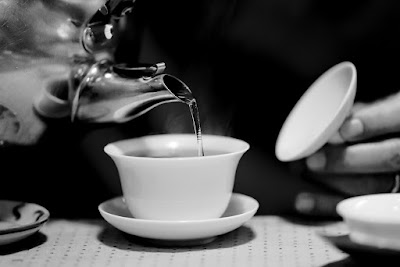We started with this Hung Shui Oolong from Feng Huang, winter 2017. This is an excellent example of what a Dong Ding Oolong is and should taste like. The cultivar is Qingxin Oolong and it's grown in Feng Huang, one of the villages that are part of the rather small Dong Ding area. The winter season and the spring season both see the Dong Ding Oolong take place. It was created in 1976 by the director of the Taiwan Research and Extension Station (TRES, Taiwan's tea research institute) to raise quality by using a standard taste close to that of WuYi Oolongs (which were not available in Taiwan at the time, due to the ongoing conflict between China and Taiwan.) The reason for choosing this Hung Shui Oolong is that it comes closest, in my opinion, to the ideal Dong Ding Oolong: the roasting hasn't burned the leaves and they still unfold very nicely. The aromas have been positively impacted by the roasting. There are scents of walnuts, chestnuts, but also fresh fruity smells. And the taste is both long and sweet. This batch is less roasted than typical competition Dong Ding Oolongs.
The next tea on our list was the spring 2016 Hung Shui Oolong from Alishan. The purpose of this tea is to understand that Dong Ding Oolong has become so famous in the 1980s, that such teas were (and still are) produced all over Taiwan. That's why the name Hung Shui Oolong has come up to describe an Oolong that has been produced with a typical Dong Ding Oolong process. This one comes from Alishan, from a higher elevation than the Dong Ding area. It's also made from Qingxin Oolong leaves. Using high mountain leaves is a strategy used to make finer and more powerful Hung Shui Oolong. That's why most teas that win the Dong Ding Oolong competition don't come from Dong Ding, but from Shan Lin Xi or even Lishan! What's also interesting is that this Alishan Hung Shui Oolong has a stronger roast, which adds even more dark aromas to the brew.
The varying roasting level is what makes Oolong so complex and so fascinating. Other teas are not roasted, but simply dried. Thanks to the roast, new flavors appear. The brew become malty and reminds us of a brandy! This also has a big impact on how the leaves are best brewed. That's what Sarah and Rattana could learn and practice with me. (I explain the brewing in my TeaMasters guide to Brewing Oolong tea, which I offer for any order of 60 USD or more.)
 |
| It's SO good! |
 |
| 2010 fall OB |
The zhuo yan Oolong from Yong Lung is like a bridge between Hung Shui Oolong and Oriental Beauty Oolong. So, tasting an Oriental Beauty just after the zhuo yan Oolong (or a concubine Oolong, which is not the same) helps to clarify the characteristics of each type of Oolong.
This was really a class, because we only used this ivory white porcelain gaiwan. An Yixing teapot could have given us a deeper and smoother taste, but the porcelain gaiwan brings more clarity and truth to the aromas.
Before I mention the next Oolong we brewed to conclude this lesson, I want to point out that these 2 and the following pictures were taken by Rattana with my Nikon D750. He's an accomplished professional photographer and I'm very grateful for the art he has created and his permission to share his photos here.
The most liked picture of 2018 is a black and white picture and these look stunning! The white porcelain enhances the purity of this tea experience!
It also makes sense to use black and white now, because we tasted this aged 1999 Hung Shui Oolong from Yong Lung (Dong Ding) as our last tea.
It takes us back 20 years ago. We notice that the leaves are mostly single, ie not attached to one another on a stem like nowadays. The look of dry leaves is already more refined!
Their aged aromas are very different from a newly roasted Hung Shui Oolong. It's difficult to describe. In wine, they are called tertiary aromas, scents that are not the result of a specific process, but of time. The taste is smoother, less powerful also.
But the character of Dong Ding remains the same.
Brew after brew and cup after cup.
I hope you all had a great start in 2019! I couldn't have dreamed a better one myself. Thank you Rattana for capturing the beauty of this dark dragon!




















No comments:
Post a Comment